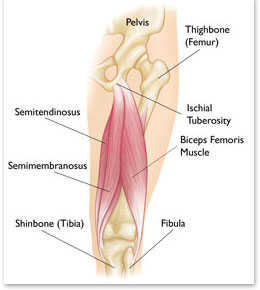HOW DO THEY OCCUR?
Hamstring strains/injuries and ruptures are common in contact sports such as football and rugby but equally so in non-contact sports such as track and field and sprinting. The hamstring injury tends to occur, either whilst sprinting or when overstretching the hamstring muscle to lunge forwards to kick a ball.
After an initial hamstring strain injury reoccurrence is likely.
Hamstring weakness, fatigue and lack of flexibility are risk factors that can make the individuals prone to these types of injuries.
WHAT DOES IT FEEL LIKE?
The symptoms of a hamstring strain are described as a sudden pain at the back of the thigh and are classified into 3 Grades: mild, moderate and severe, according to the extent of the damage to the muscle. Pain, bruising, swelling and partial or complete weakness are the signs and symptoms of this type of injury.
HOW DO YOU TREAT THIS CONDITION?
Proper rehabilitation with a physiotherapist is key following this type of injury to enable the return to one’s previous level of performance. Experienced physiotherapists aim to prevent reoccurrence by strengthening the surrounding muscles to support the area that unfortunately heals with some scar tissue which is weaker than its original tissue. Also, it is important to restore full flexibility of the healing tissue as scar tissue is also less elastic than its original tissue.
If you have a hamstring strain or rupture and require some advice or “hands on” physiotherapy by one of our expert physiotherapists, please call us on 020 7183 4436.
By Anat Meier MSc MCSP SRP
Senior Physiotherapist




